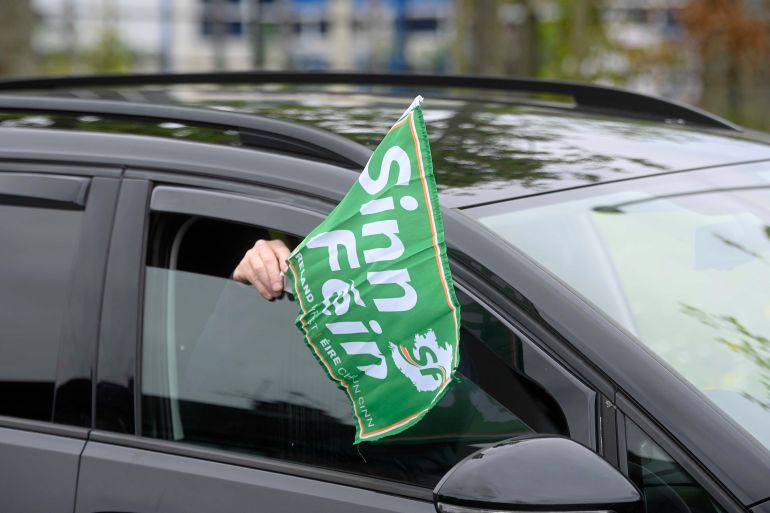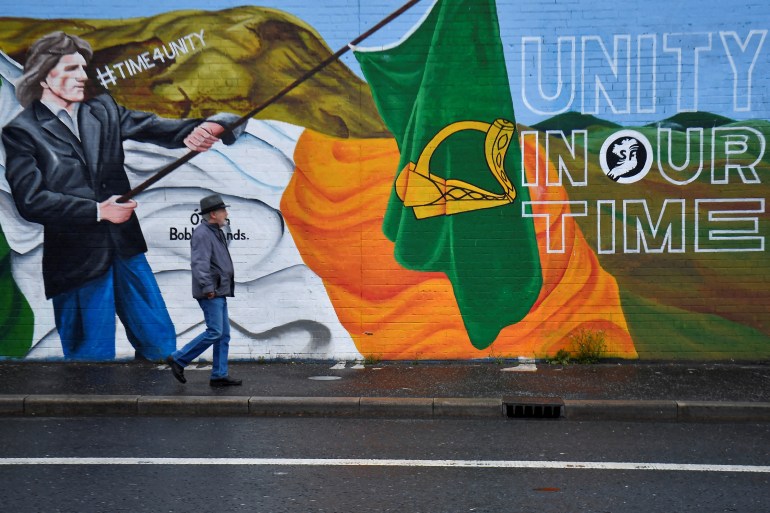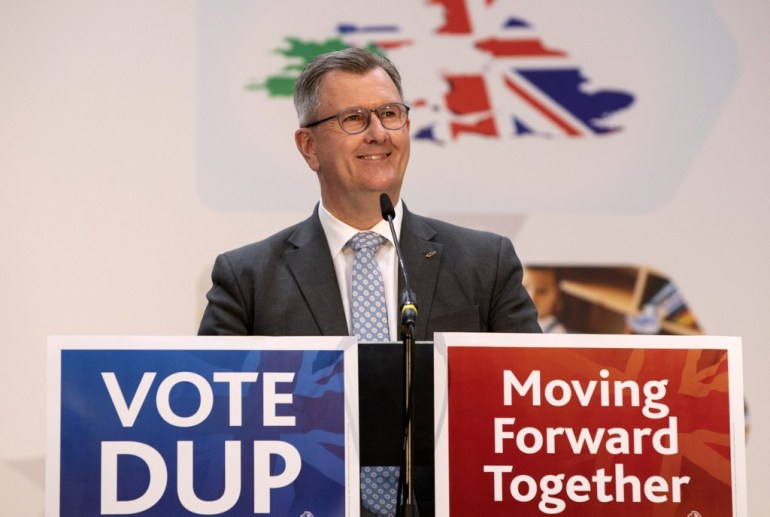Northern Ireland witnesses ‘seismic’ legislative election result
A pro-Irish reunification party becomes the biggest one in Northern Ireland’s legislative assembly for the first time.

Belfast, United Kingdom – Northern Ireland has witnessed a “seismic” election result after Thursday’s legislative vote.
Sinn Féin, a party that supports the reunification of Ireland and was once the political wing of the IRA, has become the biggest party in the legislative assembly.
Keep reading
list of 1 itemWinning the most seats entitles Sinn Féin to the post of First Minister, making it the first time in Northern Ireland’s 101 year history that this post was not held by a unionist, who support remaining part of the United Kingdom.
The party managed to not only consolidate their vote but also increase it significantly, winning the largest vote share with 250,388 first preferences, compared with 184,002 for the nearest rivals, the Democratic Unionist Party (DUP).
Middle-ground parties such as the Ulster Unionists, the SDLP, and the Green Party were also squeezed, with prominent figures losing their seats.
Sinn Féin party leader Mary Lou McDonald, a member of parliament in the Republic of Ireland and on course to be the biggest party there by 2025, described the result as “an election of a generation”.
“It’s seismic in terms of what it represents,” Jon Tonge, professor of politics at the University of Liverpool and an expert on the region, told Al Jazeera.
Sinn Féin becoming the largest party “is extraordinary given the history of the state”, he said.
Any referendum on a united Ireland, a longtime aim of Sinn Féin and a key focus by the DUP in this election, can only be called by the British Secretary of State and is at least years away.
However, the election results are “another incremental step along that road”, said Tonge.
This is especially the case if in a few years’ time Sinn Féin is the largest party in both jurisdictions on the island of Ireland.
Speaking at a Belfast count centre about the prospects for a united Ireland, Sinn Féin leader McDonald told Sky News that “the preparation for that big change needs to happen now.
“We want this to happen in a way that is orderly, that is planned, that is democratic, and is peaceful,” she added, saying a referendum would “certainly” take place in this decade.
Alliance surge
The centrist Alliance party also received a surge in support, becoming the third largest party in terms of vote share and have more than doubled their seats.
Alliance define themselves as neither Irish nationalist nor unionist and do not take a position on the question of Irish unity.
The rise of this party to such prominence is a significant shift in the landscape of Northern Ireland politics.

Alliance’s David Honeyford took a new seat for his party in the Lagan Valley constituency.
He told Al Jazeera that voters in Northern Ireland are moving towards those “who prioritise the issues rather than the constitutional question”.
“We prioritise health and education, we work really hard on the ground for the issues people care about. And you’re seeing the results of that,” Honeyford said.
He acknowledged that many of their votes were coming from the middle-ground unionist, nationalist and other parties.
“The centre is solidifying around Alliance, but we’ve taken from the DUP and Sinn Féin as well,” he said. “So we’re attracting votes from right across the community.”
Jacqueline, an Alliance voter in her 30s in the Upper Bann constituency, was “delighted” at the result. She said that her mother, who was in her 60s and would have previously supported a unionist candidate, also supported Alliance in this election.
“It just goes to show that views have moved on here,” she told Al Jazeera.
Counting continues
The Ulster Unionist party (UUP) and the Irish nationalist SDLP both dropped a significant vote share.
SDLP deputy leader Nichola Mallon and former infrastructure minister failed to keep her seat, while UUP leader Doug Beatie almost lost his.
SDLP leader Colum Eastwood told media on Friday that DUP emphasis on the possibility of an Irish nationalist first minister backfired, and may have led people who normally support his party to “lend” a vote to Sinn Féin in order to “kick the DUP”.
The small but influential Green party – who passed legislation on climate change and women’s rights – had hoped to increase their vote. Instead, they lost both seats, including that of their party leader.

Meanwhile, the hardline unionist TUV party polled well, but ultimately failed to take any additional seats.
Whether the Alliance surge is an increase of vote for the centre ground or simply a realignment of votes from other middle-ground parties, the Alliance victory will call into question how government is organised in Northern Ireland.
The current power-sharing agreement put in place following the end of The Troubles has until now being dominated by the two blocs of nationalism and unionism.
Deirdre Heenan, professor of social policy at Ulster University, said that model was “based on the idea that there are two ethno-national blocks, the unionists and nationalists, and that they are fixed, and they are autonomous”.
While those arrangements may have represented Northern Irish society when the Good Friday Agreement was negotiated 25 years ago, Heenan told Al Jazeera: “The first question that we really need to ask ourselves is – is it still true today?
“The rise of the middle means that we are in a different position. We don’t have two large blocks of divided communities. We have three minority communities, unionists, nationalist and other.”
What’s next?
Once the final results are in, the parties will go into a negotiation process with a view to forming a new power-sharing executive between the parties.
Hanging over this prospect is the fact that the DUP have said they will not go into a new government until issues surrounding the Northern Ireland protocol are resolved.
The protocol, a post-Brexit agreement which creates a trade border in the Irish sea to avoid a land border on the island of Ireland, is fiercely opposed by all unionist parties and an important issue for many unionist voters.
While the actual economic effect of the protocol on Northern Ireland is contested, it is perceived by many to be a weakening of the link with the rest of the UK and its place in the union is under threat.
The DUP walked out of government in February over the issue.
Any resolution will likely take months to be resolved. In the meantime, a caretaker government with the ministers currently in place will be able to make some decisions, but not on important issues like budgets.

DUP leader Jeffrey Donaldson remained vague on whether Northern Ireland will have devolved government in 2022, telling media at the Belfast count centre on Saturday: “Let’s cross all the bridges when we get to them.”
This situation amounts to a serious challenge to power-sharing in Northern Ireland, Professor Tonge told Al Jazeera.
“The DUP is not going to be jumping back in. They pulled out in February, so why would they return in May, when they can’t nominate even a First Minister, and there’s no movement on the protocol?” he said.
“It’s the biggest crisis for the Good Friday Agreement and political institutions since those early post-conflict years.”